TOYOTA GR YARIS 2022 Owners Manual
Manufacturer: TOYOTA, Model Year: 2022, Model line: GR YARIS, Model: TOYOTA GR YARIS 2022Pages: 470, PDF Size: 113.17 MB
Page 121 of 470
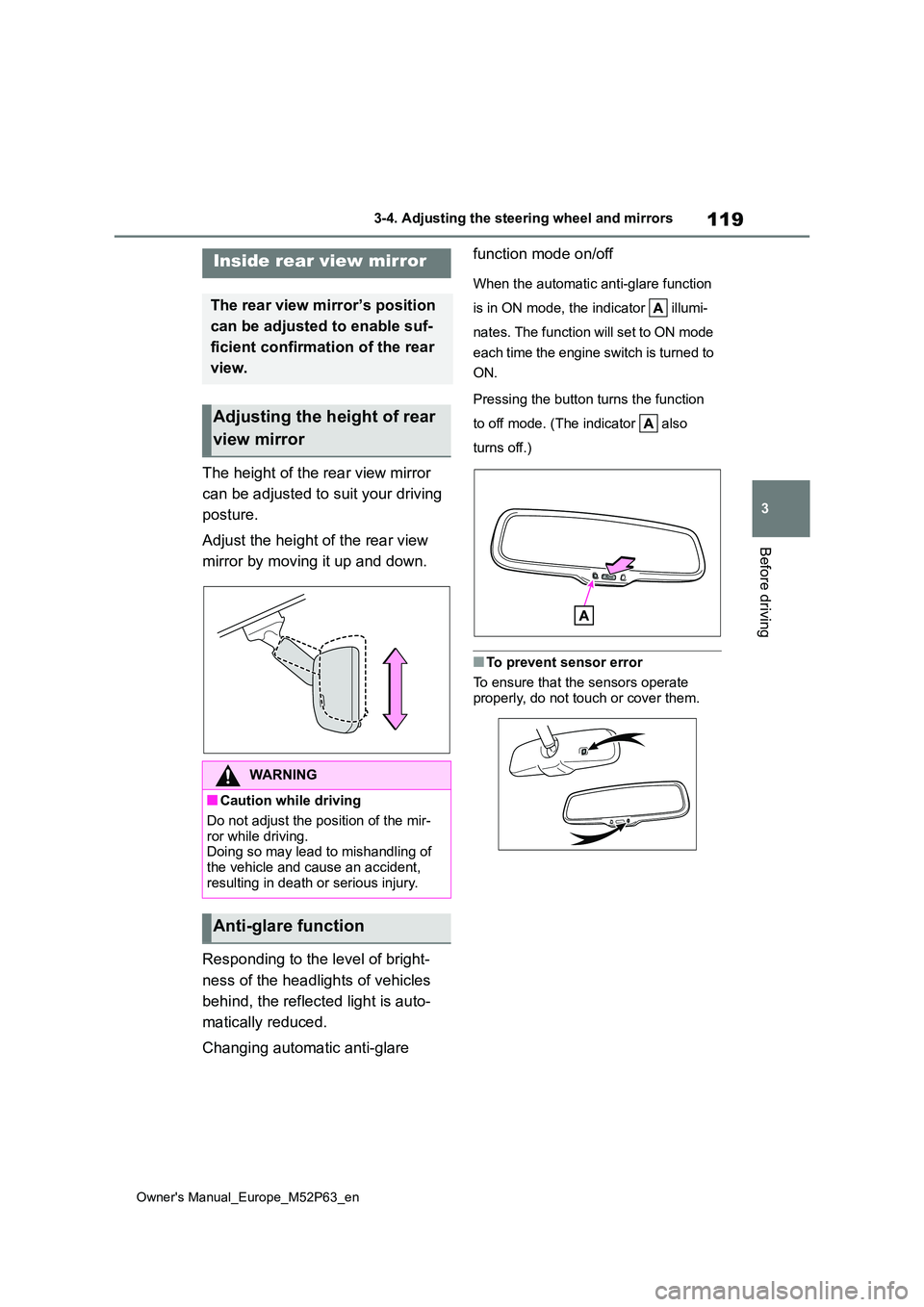
119
3
Owner's Manual_Europe_M52P63_en
3-4. Adjusting the steering wheel and mirrors
Before driving
The height of the rear view mirror
can be adjusted to suit your driving
posture.
Adjust the height of the rear view
mirror by moving it up and down.
Responding to the level of bright-
ness of the headlights of vehicles
behind, the reflected light is auto-
matically reduced.
Changing automatic anti-glare
function mode on/off
When the automatic anti-glare function
is in ON mode, the indicator illumi-
nates. The function will set to ON mode
each time the engine switch is turned to
ON.
Pressing the button turns the function
to off mode. (The indicator also
turns off.)
■To prevent sensor error
To ensure that the sensors operate properly, do not touch or cover them.
Inside rear view mirror
The rear view mirror’s position
can be adjusted to enable suf-
ficient confirmation of the rear
view.
Adjusting the height of rear
view mirror
WARNING
■Caution while driving
Do not adjust the position of the mir-
ror while driving. Doing so may lead to mishandling of the vehicle and cause an accident,
resulting in death or serious injury.
Anti-glare function
Page 122 of 470
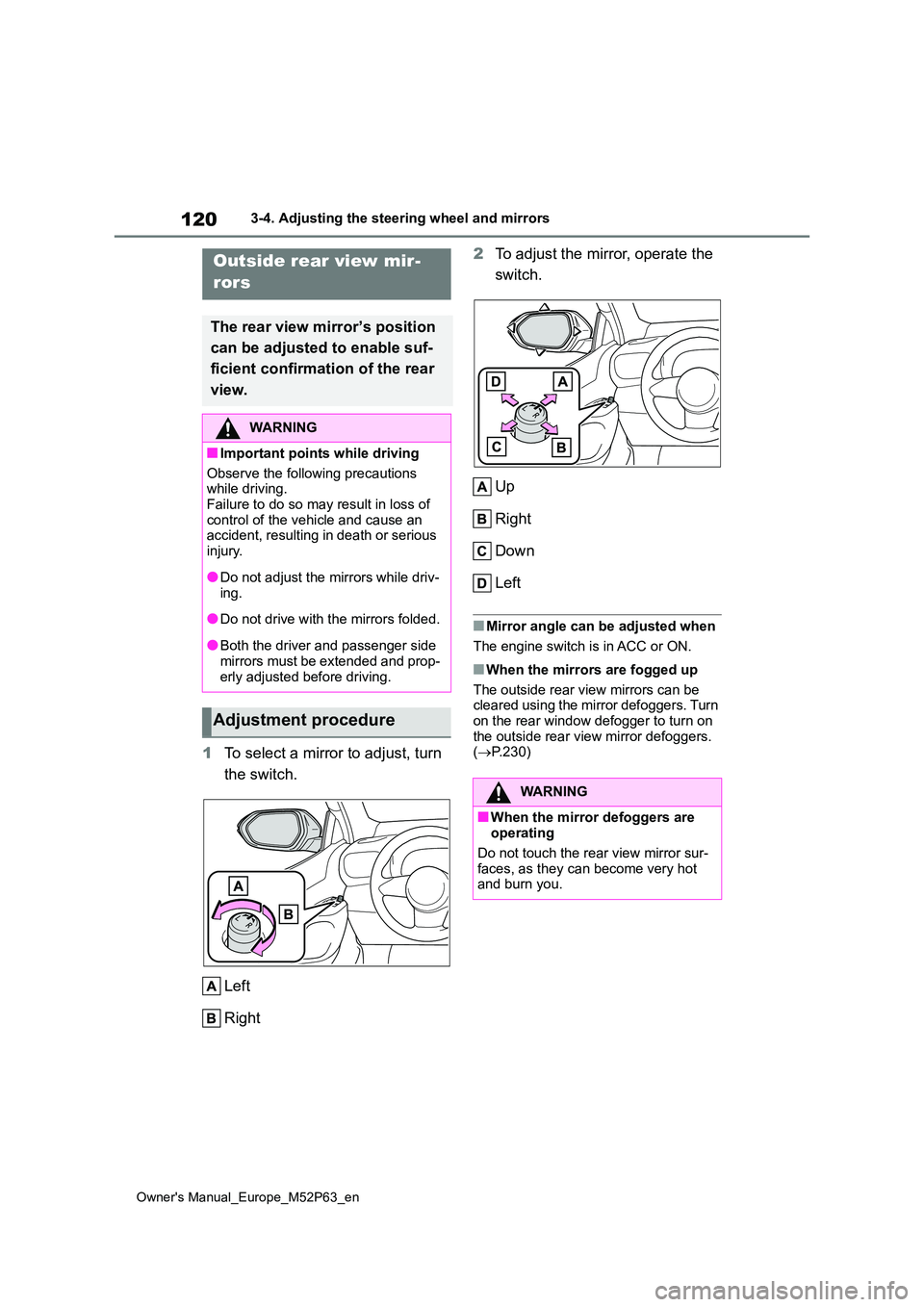
120
Owner's Manual_Europe_M52P63_en
3-4. Adjusting the steering wheel and mirrors
1To select a mirror to adjust, turn
the switch.
Left
Right
2 To adjust the mirror, operate the
switch.
Up
Right
Down
Left
■Mirror angle can be adjusted when
The engine switch is in ACC or ON.
■When the mirrors are fogged up
The outside rear view mirrors can be cleared using the mirror defoggers. Turn
on the rear window defogger to turn on the outside rear view mirror defoggers. ( P.230)
Outside rear view mir-
rors
The rear view mirror’s position
can be adjusted to enable suf-
ficient confirmation of the rear
view.
WARNING
■Important points while driving
Observe the following precautions while driving.
Failure to do so may result in loss of control of the vehicle and cause an accident, resulting in death or serious
injury.
●Do not adjust the mirrors while driv-
ing.
●Do not drive with the mirrors folded.
●Both the driver and passenger side mirrors must be extended and prop-
erly adjusted before driving.
Adjustment procedure
WARNING
■When the mirror defoggers are operating
Do not touch the rear view mirror sur-
faces, as they can become very hot and burn you.
Page 123 of 470
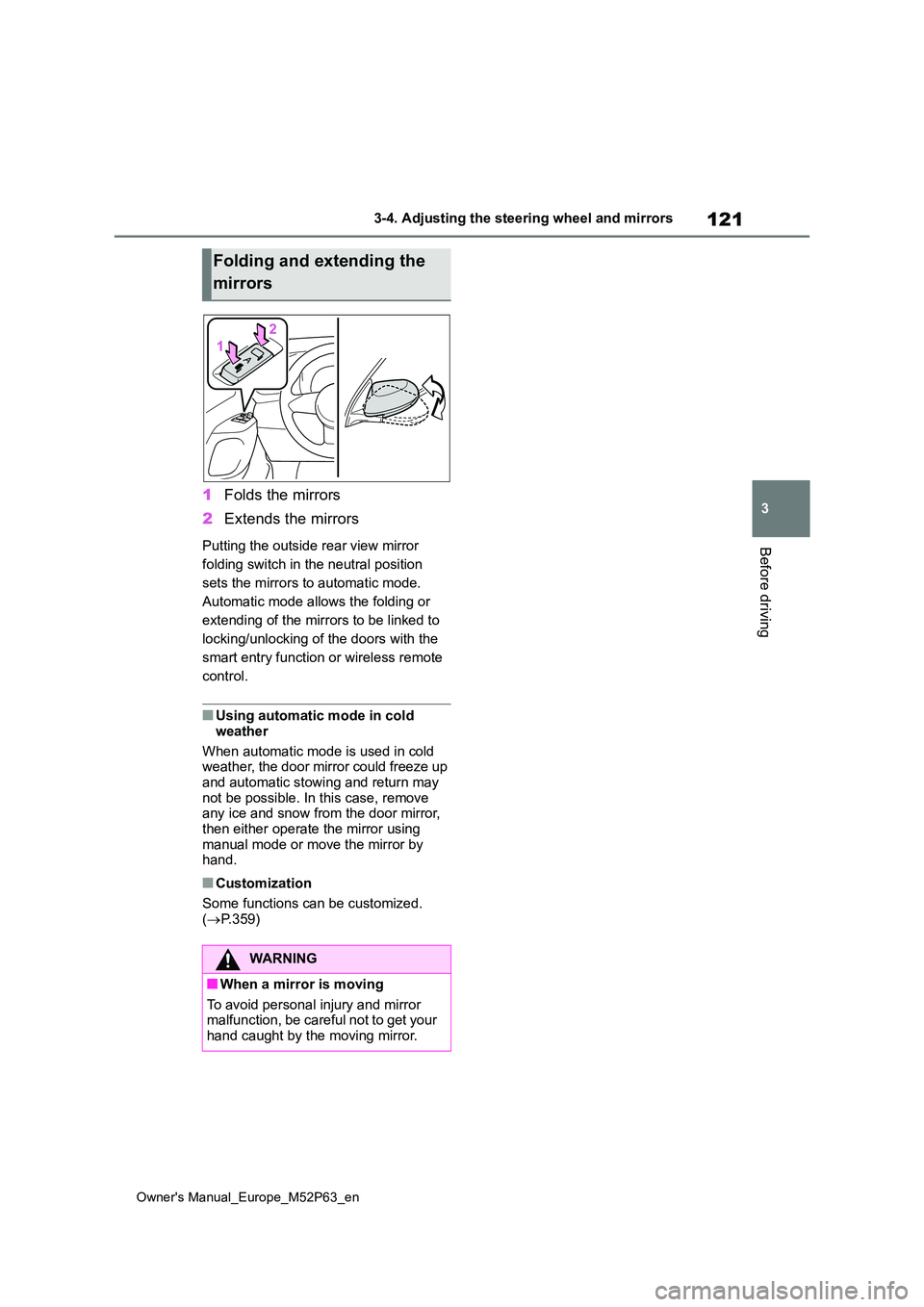
121
3
Owner's Manual_Europe_M52P63_en
3-4. Adjusting the steering wheel and mirrors
Before driving
1Folds the mirrors
2 Extends the mirrors
Putting the outside rear view mirror
folding switch in the neutral position
sets the mirrors to automatic mode.
Automatic mode allows the folding or
extending of the mirrors to be linked to
locking/unlocking of the doors with the
smart entry function or wireless remote
control.
■Using automatic mode in cold
weather
When automatic mode is used in cold weather, the door mirror could freeze up
and automatic stowing and return may not be possible. In this case, remove any ice and snow from the door mirror,
then either operate the mirror using manual mode or move the mirror by hand.
■Customization
Some functions can be customized. ( P.359)
Folding and extending the
mirrors
WARNING
■When a mirror is moving
To avoid personal injury and mirror malfunction, be careful not to get your hand caught by the moving mirror.
Page 124 of 470
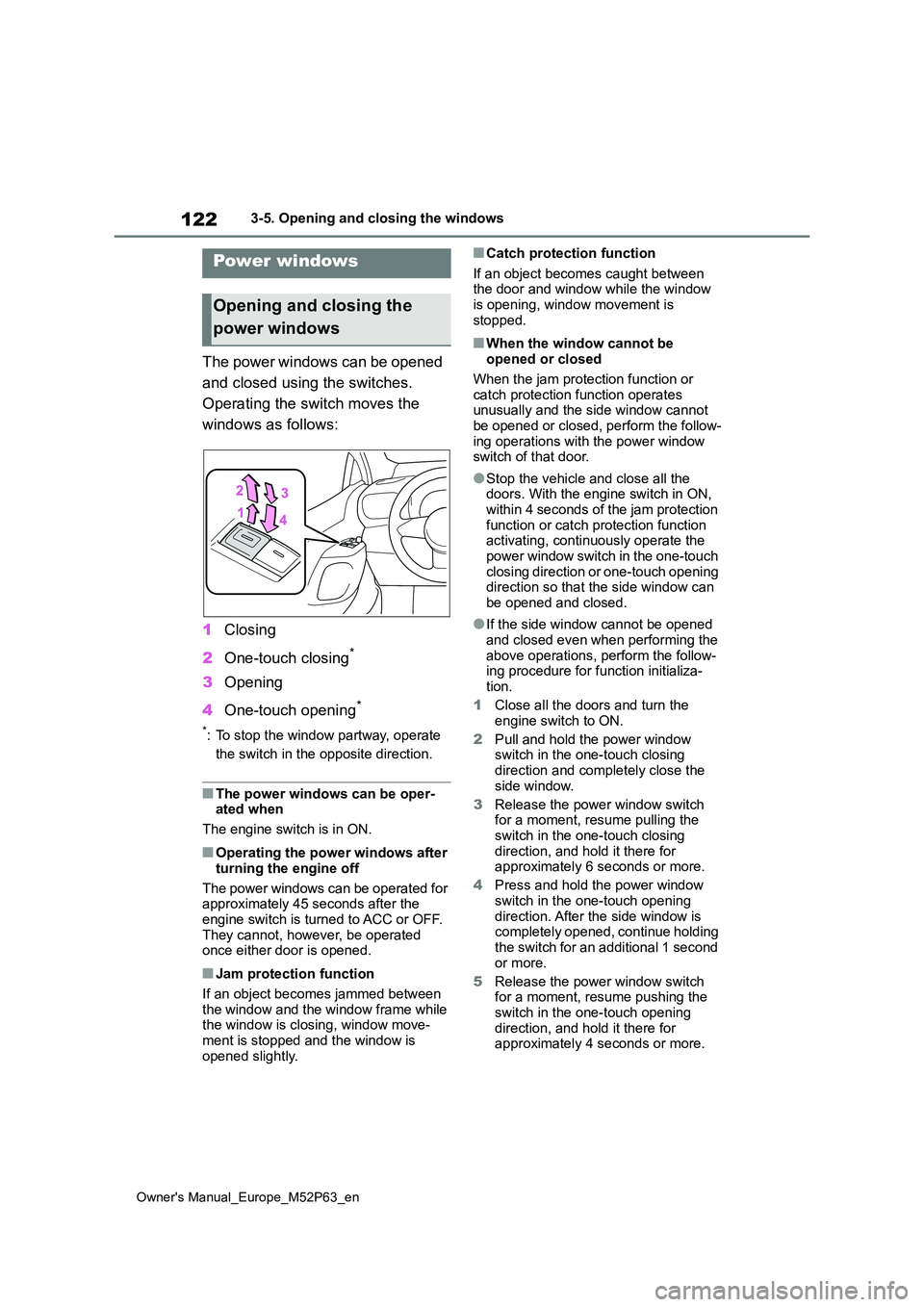
122
Owner's Manual_Europe_M52P63_en
3-5. Opening and closing the windows
3-5.Opening and c los ing the win dows
The power windows can be opened
and closed using the switches.
Operating the switch moves the
windows as follows:
1 Closing
2 One-touch closing*
3Opening
4 One-touch opening*
*: To stop the window partway, operate
the switch in the opposite direction.
■The power windows can be oper- ated when
The engine switch is in ON.
■Operating the power windows after
turning the engine off
The power windows can be operated for approximately 45 seconds after the
engine switch is turned to ACC or OFF. They cannot, however, be operated once either door is opened.
■Jam protection function
If an object becomes jammed between the window and the window frame while the window is closing, window move-
ment is stopped and the window is opened slightly.
■Catch protection function
If an object becomes caught between the door and window while the window is opening, window movement is
stopped.
■When the window cannot be opened or closed
When the jam protection function or
catch protection function operates unusually and the side window cannot be opened or closed, perform the follow-
ing operations with the power window switch of that door.
●Stop the vehicle and close all the doors. With the engine switch in ON, within 4 seconds of the jam protection
function or catch protection function activating, continuously operate the power window switch in the one-touch
closing direction or one-touch opening direction so that the side window can be opened and closed.
●If the side window cannot be opened and closed even when performing the
above operations, perform the follow- ing procedure for function initializa-tion.
1 Close all the doors and turn the
engine switch to ON.
2 Pull and hold the power window switch in the one-touch closing direction and completely close the
side window.
3 Release the power window switch for a moment, resume pulling the switch in the one-touch closing
direction, and hold it there for approximately 6 seconds or more.
4 Press and hold the power window switch in the one-touch opening
direction. After the side window is completely opened, continue holding the switch for an additional 1 second
or more.
5 Release the power window switch for a moment, resume pushing the switch in the one-touch opening
direction, and hold it there for approximately 4 seconds or more.
Power windows
Opening and closing the
power windows
Page 125 of 470
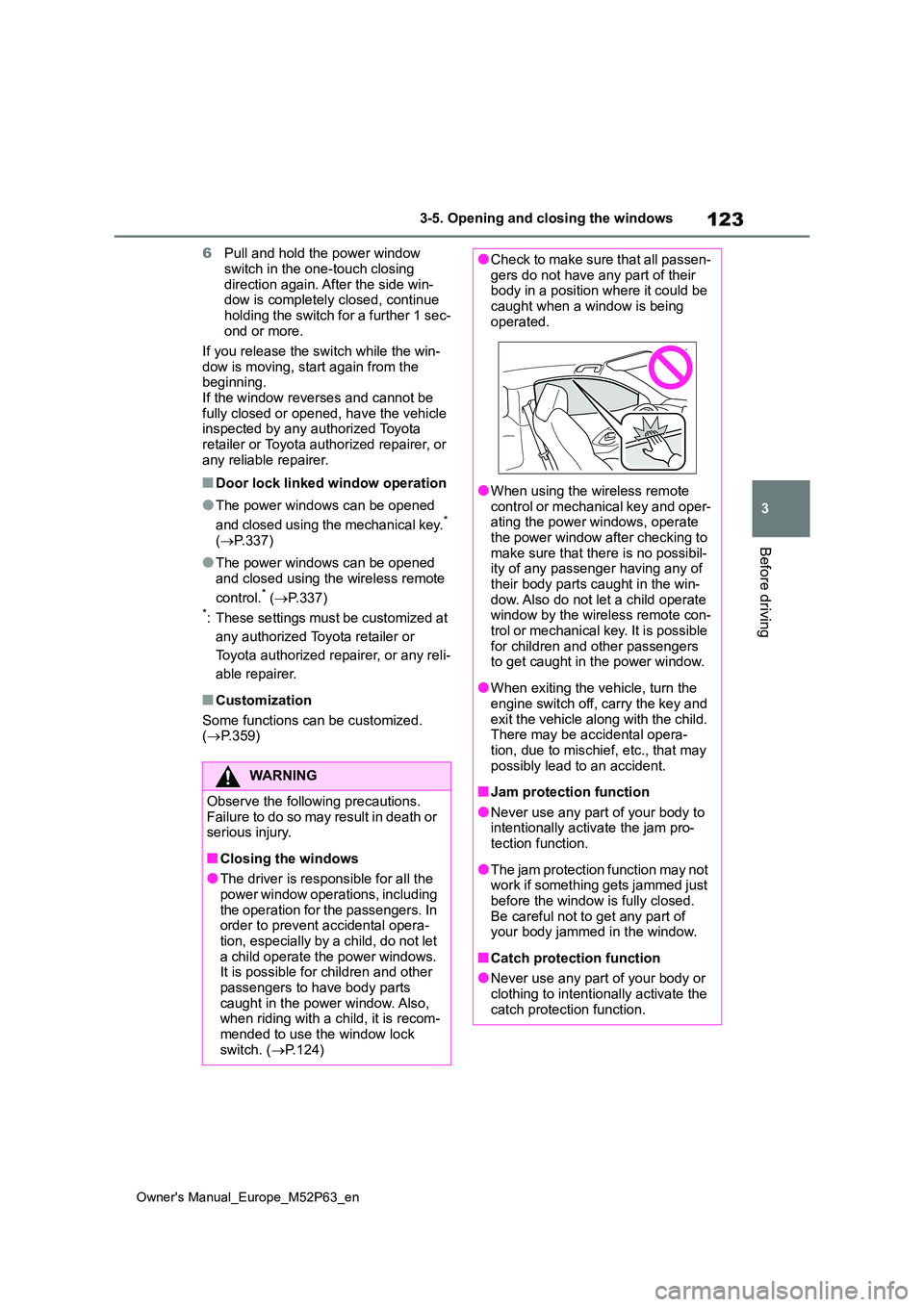
123
3
Owner's Manual_Europe_M52P63_en
3-5. Opening and closing the windows
Before driving
6Pull and hold the power window
switch in the one-touch closing direction again. After the side win-dow is completely closed, continue
holding the switch for a further 1 sec- ond or more.
If you release the switch while the win-
dow is moving, start again from the beginning.If the window reverses and cannot be
fully closed or opened, have the vehicle inspected by any authorized Toyota retailer or Toyota authorized repairer, or
any reliable repairer.
■Door lock linked window operation
●The power windows can be opened
and closed using the mechanical key.* ( P.337)
●The power windows can be opened
and closed using the wireless remote
control.* ( P.337)*: These settings must be customized at
any authorized Toyota retailer or
Toyota authorized repairer, or any reli-
able repairer.
■Customization
Some functions can be customized. ( P.359)
WARNING
Observe the following precautions. Failure to do so may result in death or serious injury.
■Closing the windows
●The driver is responsible for all the
power window operations, including the operation for the passengers. In order to prevent accidental opera-
tion, especially by a child, do not let a child operate the power windows. It is possible for children and other
passengers to have body parts caught in the power window. Also, when riding with a child, it is recom-
mended to use the window lock switch. ( P.124)
●Check to make sure that all passen- gers do not have any part of their body in a position where it could be
caught when a window is being operated.
●When using the wireless remote control or mechanical key and oper-ating the power windows, operate
the power window after checking to make sure that there is no possibil-ity of any passenger having any of
their body parts caught in the win- dow. Also do not let a child operate window by the wireless remote con-
trol or mechanical key. It is possible for children and other passengers to get caught in the power window.
●When exiting the vehicle, turn the engine switch off, carry the key and
exit the vehicle along with the child. There may be accidental opera-tion, due to mischief, etc., that may
possibly lead to an accident.
■Jam protection function
●Never use any part of your body to intentionally activate the jam pro-tection function.
●The jam protection function may not work if something gets jammed just
before the window is fully closed. Be careful not to get any part of your body jammed in the window.
■Catch protection function
●Never use any part of your body or
clothing to intentionally activate the catch protection function.
Page 126 of 470
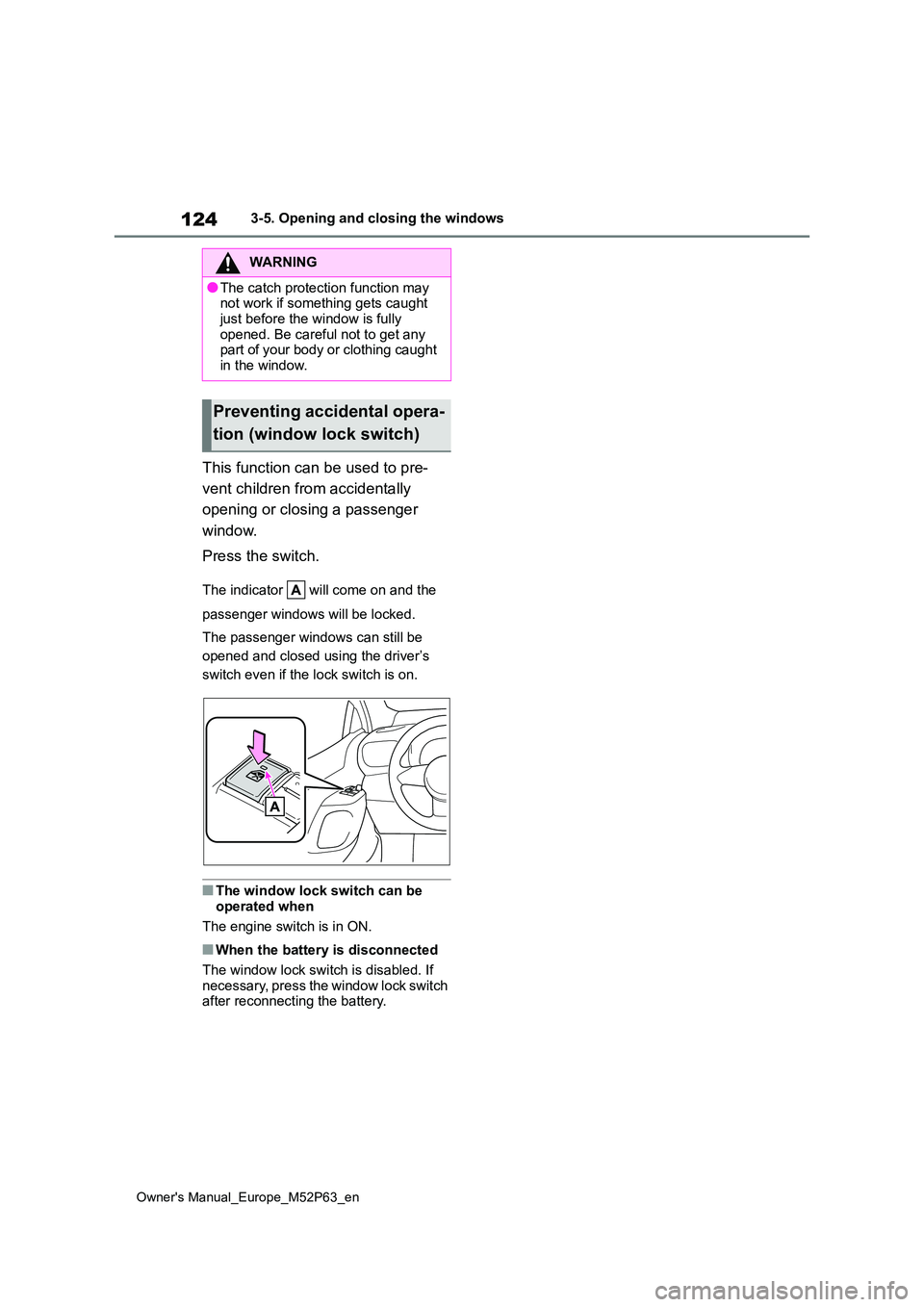
124
Owner's Manual_Europe_M52P63_en
3-5. Opening and closing the windows
This function can be used to pre-
vent children from accidentally
opening or closing a passenger
window.
Press the switch.
The indicator will come on and the
passenger windows will be locked.
The passenger windows can still be
opened and closed using the driver’s
switch even if the lock switch is on.
■The window lock switch can be
operated when
The engine switch is in ON.
■When the battery is disconnected
The window lock switch is disabled. If
necessary, press the window lock switch after reconnecting the battery.
WARNING
●The catch protection function may not work if something gets caught
just before the window is fully opened. Be careful not to get any part of your body or clothing caught
in the window.
Preventing accidental opera-
tion (window lock switch)
Page 127 of 470
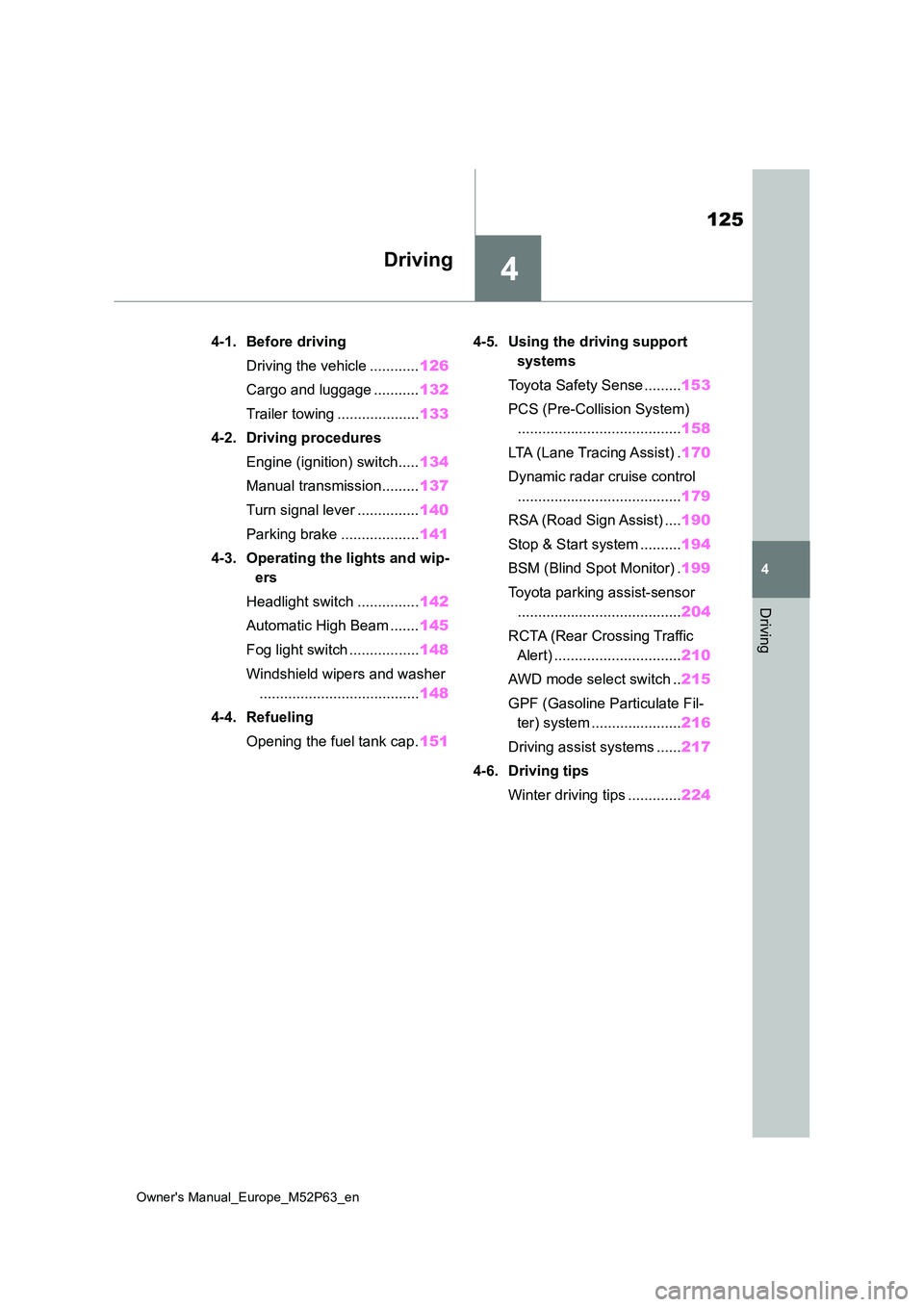
4
125
Owner's Manual_Europe_M52P63_en
4
Driving
Driving
4-1. Before driving
Driving the vehicle ............ 126
Cargo and luggage ........... 132
Trailer towing .................... 133
4-2. Driving procedures
Engine (ignition) switch..... 134
Manual transmission......... 137
Turn signal lever ............... 140
Parking brake ................... 141
4-3. Operating the lights and wip-
ers
Headlight switch ............... 142
Automatic High Beam ....... 145
Fog light switch ................. 148
Windshield wipers and washer
....................................... 148
4-4. Refueling
Opening the fuel tank cap. 151
4-5. Using the driving support
systems
Toyota Safety Sense ......... 153
PCS (Pre-Collision System)
........................................ 158
LTA (Lane Tracing Assist) . 170
Dynamic radar cruise control
........................................ 179
RSA (Road Sign Assist) .... 190
Stop & Start system .......... 194
BSM (Blind Spot Monitor) . 199
Toyota parking assist-sensor
........................................ 204
RCTA (Rear Crossing Traffic
Alert) ............................... 210
AWD mode select switch .. 215
GPF (Gasoline Particulate Fil-
ter) system ...................... 216
Driving assist systems ...... 217
4-6. Driving tips
Winter driving tips ............. 224
Page 128 of 470
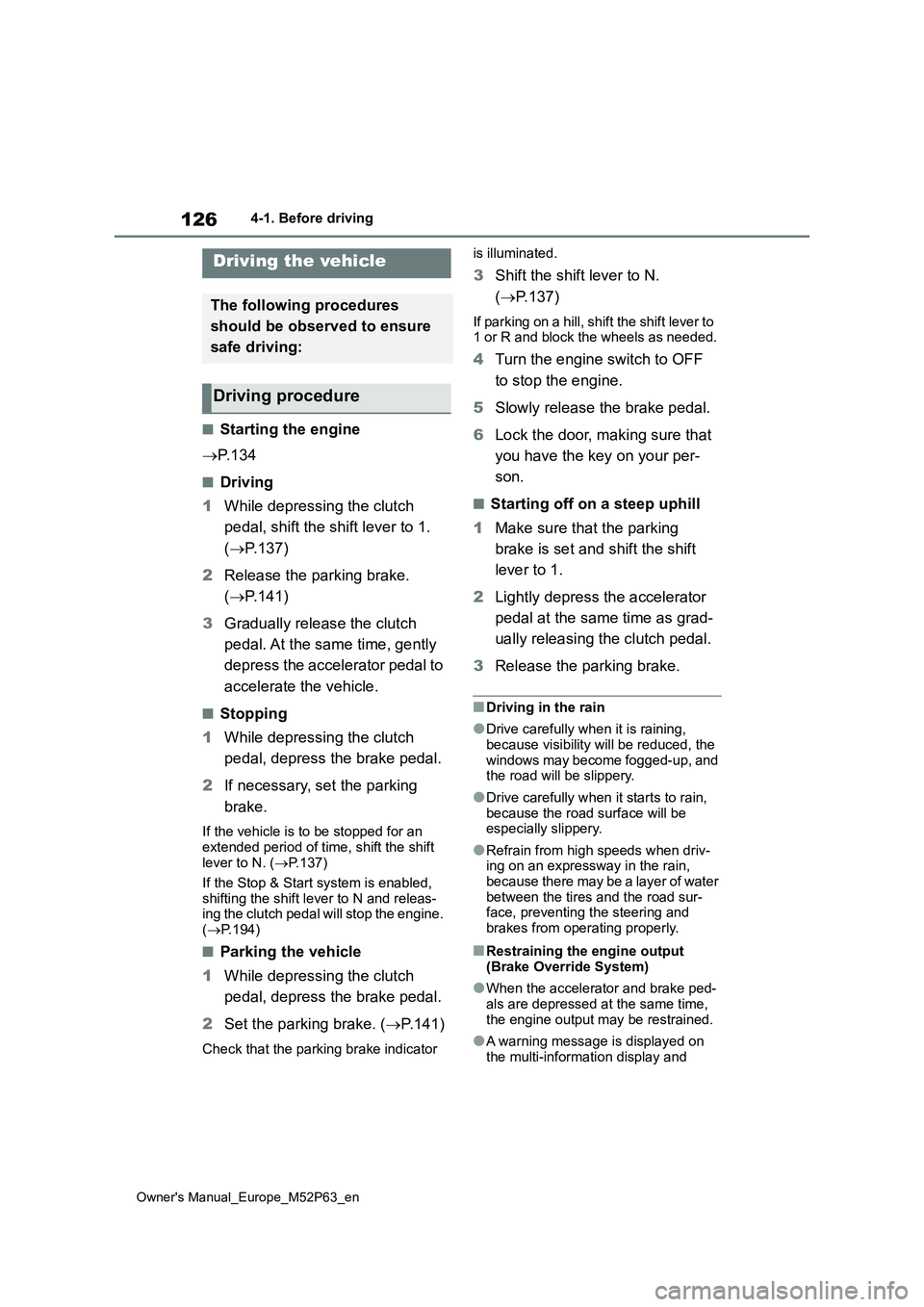
126
Owner's Manual_Europe_M52P63_en
4-1. Before driving
4-1.Before driv in g
■Starting the engine
P. 1 3 4
■Driving
1 While depressing the clutch
pedal, shift the shift lever to 1.
( P.137)
2 Release the parking brake.
( P.141)
3 Gradually release the clutch
pedal. At the same time, gently
depress the accelerator pedal to
accelerate the vehicle.
■Stopping
1 While depressing the clutch
pedal, depress the brake pedal.
2 If necessary, set the parking
brake.
If the vehicle is to be stopped for an
extended period of time, shift the shift lever to N. ( P.137)
If the Stop & Start system is enabled,
shifting the shift lever to N and releas- ing the clutch pedal will stop the engine. ( P.194)
■Parking the vehicle
1 While depressing the clutch
pedal, depress the brake pedal.
2 Set the parking brake. (P.141)
Check that the parking brake indicator
is illuminated.
3 Shift the shift lever to N.
( P.137)
If parking on a hill, shift the shift lever to 1 or R and block the wheels as needed.
4 Turn the engine switch to OFF
to stop the engine.
5 Slowly release the brake pedal.
6 Lock the door, making sure that
you have the key on your per-
son.
■Starting off on a steep uphill
1 Make sure that the parking
brake is set and shift the shift
lever to 1.
2 Lightly depress the accelerator
pedal at the same time as grad-
ually releasing the clutch pedal.
3 Release the parking brake.
■Driving in the rain
●Drive carefully when it is raining,
because visibility will be reduced, the windows may become fogged-up, and the road will be slippery.
●Drive carefully when it starts to rain,
because the road surface will be especially slippery.
●Refrain from high speeds when driv-ing on an expressway in the rain, because there may be a layer of water
between the tires and the road sur- face, preventing the steering and brakes from operating properly.
■Restraining the engine output
(Brake Override System)
●When the accelerator and brake ped-
als are depressed at the same time, the engine output may be restrained.
●A warning message is displayed on the multi-information display and
Driving the vehicle
The following procedures
should be observed to ensure
safe driving:
Driving procedure
Page 129 of 470
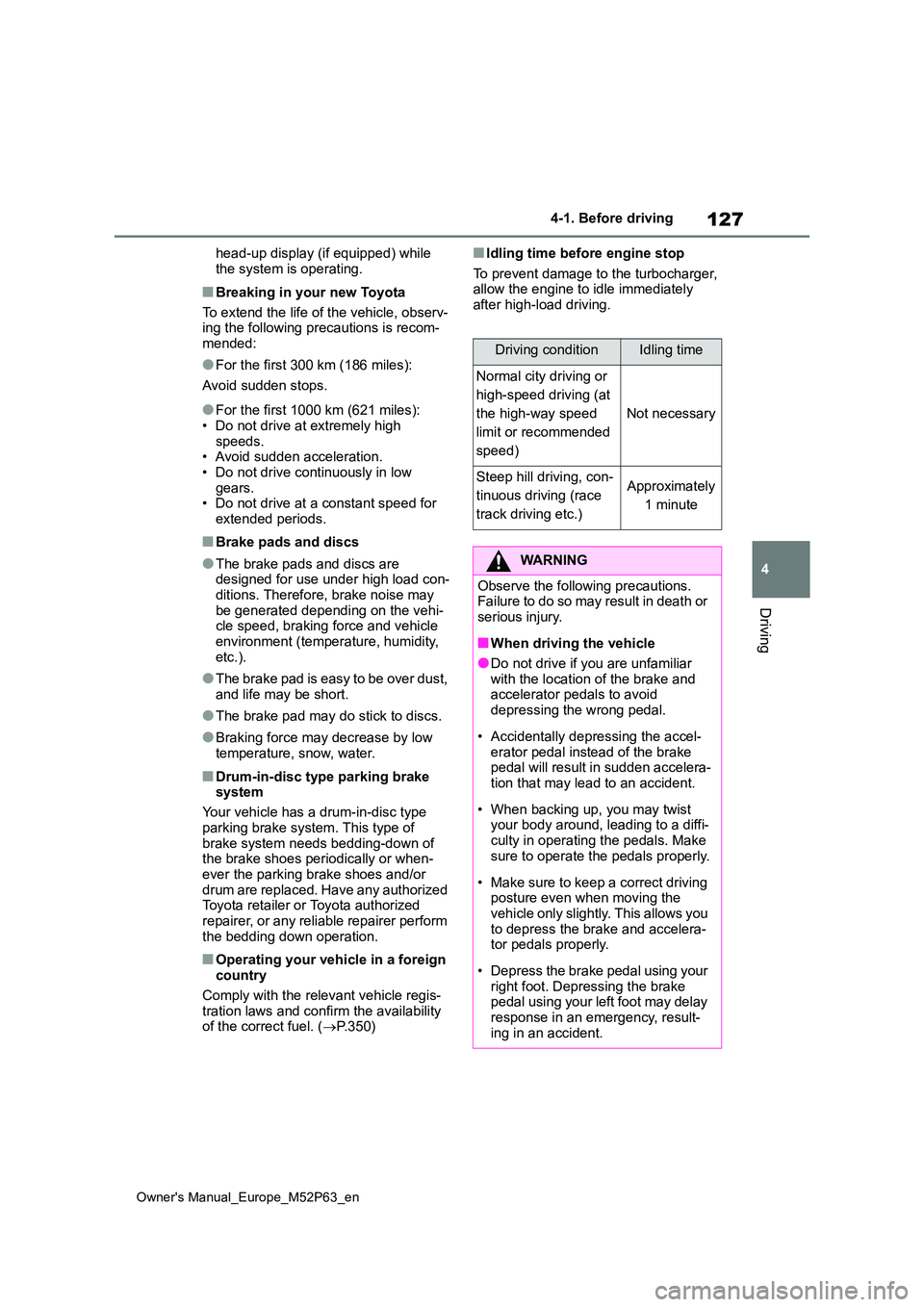
127
4
Owner's Manual_Europe_M52P63_en
4-1. Before driving
Driving
head-up display (if equipped) while
the system is operating.
■Breaking in your new Toyota
To extend the life of the vehicle, observ- ing the following precautions is recom-
mended:
●For the first 300 km (186 miles):
Avoid sudden stops.
●For the first 1000 km (621 miles): • Do not drive at extremely high
speeds. • Avoid sudden acceleration.• Do not drive continuously in low
gears. • Do not drive at a constant speed for extended periods.
■Brake pads and discs
●The brake pads and discs are designed for use under high load con-
ditions. Therefore, brake noise may be generated depending on the vehi-cle speed, braking force and vehicle
environment (temperature, humidity, etc.).
●The brake pad is easy to be over dust, and life may be short.
●The brake pad may do stick to discs.
●Braking force may decrease by low
temperature, snow, water.
■Drum-in-disc type parking brake system
Your vehicle has a drum-in-disc type
parking brake system. This type of brake system needs bedding-down of the brake shoes periodically or when-
ever the parking brake shoes and/or drum are replaced. Have any authorized Toyota retailer or Toyota authorized
repairer, or any reliable repairer perform the bedding down operation.
■Operating your vehicle in a foreign country
Comply with the relevant vehicle regis- tration laws and confirm the availability of the correct fuel. ( P.350)
■Idling time before engine stop
To prevent damage to the turbocharger, allow the engine to idle immediately after high-load driving.
Driving conditionIdling time
Normal city driving or
high-speed driving (at
the high-way speed
limit or recommended
speed)
Not necessary
Steep hill driving, con-
tinuous driving (race
track driving etc.)
Approximately
1 minute
WARNING
Observe the following precautions. Failure to do so may result in death or
serious injury.
■When driving the vehicle
●Do not drive if you are unfamiliar with the location of the brake and accelerator pedals to avoid
depressing the wrong pedal.
• Accidentally depressing the accel-
erator pedal instead of the brake pedal will result in sudden accelera-tion that may lead to an accident.
• When backing up, you may twist your body around, leading to a diffi-
culty in operating the pedals. Make sure to operate the pedals properly.
• Make sure to keep a correct driving posture even when moving the vehicle only slightly. This allows you
to depress the brake and accelera- tor pedals properly.
• Depress the brake pedal using your right foot. Depressing the brake pedal using your left foot may delay
response in an emergency, result- ing in an accident.
Page 130 of 470
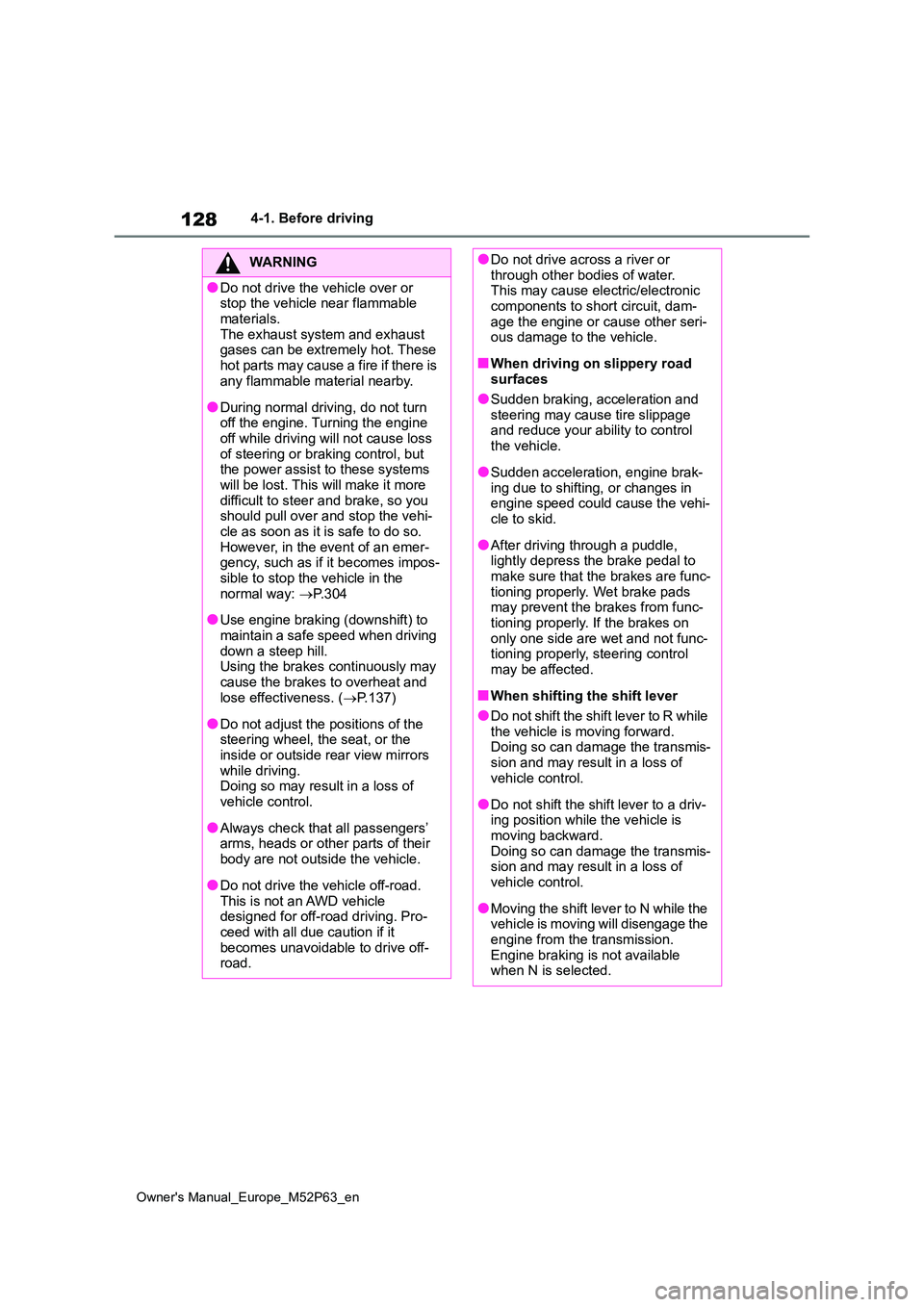
128
Owner's Manual_Europe_M52P63_en
4-1. Before driving
WARNING
●Do not drive the vehicle over or stop the vehicle near flammable
materials. The exhaust system and exhaust gases can be extremely hot. These
hot parts may cause a fire if there is any flammable material nearby.
●During normal driving, do not turn off the engine. Turning the engine off while driving will not cause loss
of steering or braking control, but the power assist to these systems will be lost. This will make it more
difficult to steer and brake, so you should pull over and stop the vehi-cle as soon as it is safe to do so.
However, in the event of an emer- gency, such as if it becomes impos-sible to stop the vehicle in the
normal way: P. 3 0 4
●Use engine braking (downshift) to
maintain a safe speed when driving down a steep hill.Using the brakes continuously may
cause the brakes to overheat and lose effectiveness. ( P.137)
●Do not adjust the positions of the steering wheel, the seat, or the inside or outside rear view mirrors
while driving. Doing so may result in a loss of vehicle control.
●Always check that all passengers’ arms, heads or other parts of their
body are not outside the vehicle.
●Do not drive the vehicle off-road.
This is not an AWD vehicle designed for off-road driving. Pro-ceed with all due caution if it
becomes unavoidable to drive off- road.
●Do not drive across a river or through other bodies of water.This may cause electric/electronic
components to short circuit, dam- age the engine or cause other seri-ous damage to the vehicle.
■When driving on slippery road surfaces
●Sudden braking, acceleration and steering may cause tire slippage and reduce your ability to control
the vehicle.
●Sudden acceleration, engine brak-
ing due to shifting, or changes in engine speed could cause the vehi-cle to skid.
●After driving through a puddle, lightly depress the brake pedal to
make sure that the brakes are func- tioning properly. Wet brake pads may prevent the brakes from func-
tioning properly. If the brakes on only one side are wet and not func-tioning properly, steering control
may be affected.
■When shifting the shift lever
●Do not shift the shift lever to R while the vehicle is moving forward.Doing so can damage the transmis-
sion and may result in a loss of vehicle control.
●Do not shift the shift lever to a driv-ing position while the vehicle is moving backward.
Doing so can damage the transmis- sion and may result in a loss of vehicle control.
●Moving the shift lever to N while the vehicle is moving will disengage the
engine from the transmission. Engine braking is not available when N is selected.